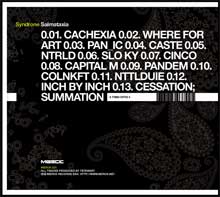
A hurricane touches down in the first thirty seconds of Salmataxia, Syndrone’s new record, a rushing, frothing explosion of sound that cores out your speaker wire, bloodies your ear canals and frightens small children within a thousand meters. It is an explosive blast of decompressing information like a hundred sets of the Encyclopedia Britannica run through a wood chipper. Syndrone’s first effort at machine music noise was Triskaideka and that record presaged the formation of Merck records; with Salmataxia, Merck is laying down the challenge that their roster of IDM junkies can take on Schematic’s crew of beat blasters. Salmataxia applies Otto Von Schirach’s methodology of zombie beat crunchery to the granular complexity of later period Autechre and tries to wrangle likeable compositions out of the mix. It takes a couple of listens to figure out if he’s successful.
I want to say that Salmataxia is a record that plays better as a whole composition instead of a series of individual tracks, but “Pan_ic” defies my attempt at that simplification. I want to argue that the divergence of melodies and beats that occurs in each track is so wide that it’s almost pointless to listen to them in any way other than as a continuous transformation of ideas and sounds. But then “Pan_ic” happens, and while the decay of its melody seems to be a radical departure from the opening theme, I can still hear the “theme” in the final minute of the track. I then hit repeat and listen to the beginning of “Pan_ic” again and, a minute later, I think: “Wait a minute. What track am I on?” It’s a confusing head-space for a reviewer to find himself in.
“Colnkft” furthers the confusions boiling in my brain. The beginning is a scraping dark ambient soundscape like something you’d hear on the spookier European noise labels. The beats drop in like spattering beads of hot lead. Syndrone then layers in an ambient melody as if we’ve just wandered into Brian Eno’s Music For Airports. Over the next seven minutes he explores various combinations of these three distinct genres as if he were demonstrating just how mutable music can be.
Normally, records that splatter beats and ideas with such a manic frenzy leave me exhausted, but Syndrone keeps my attention by providing tiny connective elements. While the explosive Chinese firecracker rhythms of “Caste” become more and more dilated as time signatures stretch, Syndrone keeps a slow tone running in the background, an sonic anchor which you can hang on to as the BPM drops towards the single digits. There are glittering tones that fall like slow meteors in “Slo ky.” “Capital M” is propelled by an Einsturzende Neubauten style clatter of plastic boxes.
Several listens later, I’ve got to answer my own question: does it work? I think the answer may be self-evident in the fact that I keep coming back to the this record. Confounding, sure, like all polyrhythmic cacophony can be, but Syndrone builds his Pollackian landscapes across placid ambient canvases. You can either float in the embrace of the big picture or lose yourself in the minute details that spill out in Mandelbrotian complexity. For both the macrocosm minded and the microscopic fetishist, Salmataxia has much to offer.
Salmataxia is out now on Merck Records.





















